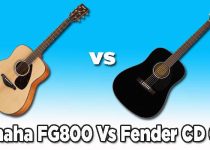Martin HD28 Vs HD35 [Difference & Which is Better]
When it comes to acoustic guitars, Martin has established itself as a premier brand known for crafting instruments that balance tradition and innovation. Among their iconic series, the Martin HD28 and HD35 stand out as remarkable choices for discerning guitarists.

In this comprehensive comparison, we delve into the nuances that set these two models apart and help you determine which one might be the better fit for your playing style and preferences.
# Table of Contents =>
Comparison Table:
| Features – | Martin HD28 | Martin HD35 |
|---|---|---|
| Top Wood | Solid Sitka Spruce | Solid Sitka Spruce |
| Back and Sides Wood | East Indian Rosewood | 3-Piece East Indian Rosewood |
| Inlays | Herringbone | Multi-Stripe |
| Sound/Tone | Balanced, Warm, Versatile | Bold, Emphasized Midrange |
| Neck Profile | Modified Low Oval | Modified Low Oval |
| Fretboard Material | Ebony | Ebony |
| Body Shape | Dreadnought | Dreadnought |
| Tonewood Influence | Balanced sound with clear highs and defined mids | Bold midrange emphasis, enhanced sustain |
| Price | Typically lower | Typically higher |
| Playability | Smooth and comfortable | Smooth and comfortable |
| Suitable for | Versatile playing styles across genres | Unique tonal emphasis, stands out in mixes |
| Ideal for | Musicians seeking a classic yet versatile sound | Players wanting a distinct tonal character |
Overview of Martin HD28 –
The Martin HD28 is a flagship dreadnought guitar that pays homage to the classic Martin designs while incorporating modern advancements. It features a solid Sitka spruce top with herringbone inlays, giving it that traditional aesthetic that enthusiasts adore.
The back and sides are crafted from East Indian rosewood, adding depth and richness to the guitar’s tonal characteristics. This combination of tonewoods results in a balanced sound with pronounced midrange and sparkling highs.
Overview of Martin HD35 –
The Martin HD35 is another powerhouse in the Martin lineup, known for its unique tonewood combination and distinct sonic qualities. While it retains some of the classic Martin design elements, it also offers a fresh perspective on sound production and projection.
The solid Sitka spruce top of the HD35 is paired with three-piece East Indian rosewood back and sides. This design choice contributes to the guitar’s enhanced sustain and complex overtones, setting it apart from the HD28.
Main Difference Between Martin HD28 Vs HD35:
a) Sound and Tone –

The HD28 is renowned for its warm and articulate tonal palette. Its Sitka spruce top enhances the responsiveness and dynamic range, making it suitable for a wide range of playing styles. The herringbone inlays on the top contribute to its vintage appeal while adding subtle tonal variations, enhancing the guitar’s projection and resonance.
The well-rounded tone of the HD28 makes it suitable for both fingerstyle and strumming. Its deep bass response provides a solid foundation, while the clear trebles ensure every note rings out distinctly. This versatility is one of the reasons why the HD28 has become a favorite among professional musicians across genres.
The HD35’s tone is characterized by its bold and vibrant presence. The three-piece back design, along with the solid Sitka spruce top, creates a dynamic interplay of frequencies. The result is a broader tonal spectrum with a focus on the midrange, which gives the HD35 a distinctive voice that can cut through mixes with clarity.
The HD35’s sustain is noteworthy, and the guitar resonates with a lush, shimmering quality. The combination of Sitka spruce and three-piece rosewood back adds layers of complexity to the sound, making it an excellent choice for players seeking a unique sonic signature.
b) Neck and Body –

The HD28 features a modified low oval neck profile that strikes a balance between comfort and playability. The neck is constructed from select hardwood, which enhances its stability and durability. The dovetail neck joint ensures a seamless connection between the neck and the body, contributing to the guitar’s overall resonance.
The dreadnought body shape of the HD28 delivers a robust and full-bodied sound. The body’s depth and width produce ample volume and projection, making it an excellent choice for solo performances and group settings alike. The combination of the Sitka spruce top and East Indian rosewood back and sides creates a harmonic richness that sets the HD28 apart.
Similar to the HD28, the HD35 features a modified low oval neck profile that prioritizes playability. The neck is also constructed from durable hardwood and features a dovetail neck joint for optimal resonance transfer. The difference lies in the tonewoods and bracing, which contribute to the HD35’s individual character.
The dreadnought body of the HD35 ensures ample volume and projection, making it suitable for various playing environments. However, the emphasis on midrange frequencies gives the HD35 a different sonic presence compared to the HD28.
c) Strings –

The HD28 typically comes equipped with Martin’s Medium Gauge Phosphor Bronze strings. These strings strike a balance between tension and flexibility, offering a comfortable playing experience across various techniques. The choice of strings also contributes to the guitar’s tonal characteristics, enhancing its warmth and brightness.
The HD35 comes strung with Martin’s High Gauge Phosphor Bronze strings. These strings provide a slightly stiffer feel compared to the Medium Gauge strings found on the HD28. The choice of strings complements the HD35’s tonal profile, adding to its bold and resonant nature.
d) Playability –
Playability is a crucial factor for any guitarist, and the HD28 excels in this aspect. The low action and well-constructed neck profile make it easy to navigate the fretboard, whether you’re playing intricate fingerstyle patterns or blazing through solos. The smooth fretwork and impeccable setup straight from the factory ensure that you’ll be able to focus on your music without any hindrance.
In terms of playability, the HD35 is on par with the HD28. The neck profile, fretwork, and setup ensure that both models offer a smooth and enjoyable playing experience. Whether you’re a fingerstyle virtuoso or a strumming enthusiast, the HD35’s comfortable neck and well-maintained frets allow you to express yourself effortlessly.
e) Price Point –
The Martin HD28 is typically priced at a point that reflects its craftsmanship, tonal qualities, and historical significance. While it may be considered an investment for some players, the HD28’s reputation for delivering consistent performance over the years makes it a valuable addition to any guitarist’s collection.
The Martin HD35 typically carries a slightly higher price tag than the HD28 due to its unique tonewood combination and distinctive tonal qualities. The investment in the HD35 reflects the guitar’s individuality and its ability to offer a sonic presence that sets it apart from other models.
Making the Right Choice?
In the choice between the Martin HD28 and HD35, both guitars offer exceptional craftsmanship, playability, and tonal qualities. The HD28 excels in its balanced and versatile sound, making it a reliable option for a wide range of musical genres. Its timeless design and warm tonal palette have solidified its place among acoustic guitar classics.
On the other hand, the HD35 stands out with its bold tonal presence and unique emphasis on midrange frequencies. If you’re seeking a guitar with a distinct sonic signature and enhanced sustain, the HD35 could be your ideal choice.
When considering price, it’s essential to recognize that both models reflect their respective tonal characteristics, craftsmanship, and materials used. The price reflects not just the instrument itself but also the legacy and expertise that Martin brings to each guitar.
Finally, your decision between the Martin HD28 vs HD35 will be influenced by your playing style, musical preferences & budget. Whichever model you choose, you can rest assured that you’re investing in a high-quality instrument that will accompany you on your musical journey for years to come.
Read: Martin D28 Vs Gibson Hummingbird [Difference]
FAQs –
Q: Which guitar is better for fingerstyle playing?
A: Both the HD28 and HD35 are well-suited for fingerstyle playing due to their comfortable neck profiles, smooth fretwork, and balanced tones. However, some players might prefer the HD35’s emphasis on midrange frequencies, which can enhance the clarity and definition of fingerstyle techniques.
Q: Can both guitars handle strumming and flatpicking equally well?
A: Yes, both the HD28 and HD35 are adept at strumming and flatpicking. The HD28’s balanced tonal characteristics make it versatile for a variety of playing styles, while the HD35’s bold midrange emphasis can add a unique character to strummed chords and flatpicked melodies.
Q: Are there any differences in playability between the HD28 and HD35?
A: Both guitars offer similar playability with their modified low oval neck profiles and well-crafted fretwork. The choice between the two models should depend more on the tonal qualities you prefer rather than differences in playability.
Q: How do the prices of the HD28 and HD35 compare?
A: The HD35 generally comes with a slightly higher price tag than the HD28. This price difference is often due to the unique tonewood combination and enhanced tonal characteristics of the HD35. Consider your budget and tonal preferences when deciding which model to invest in.
Q: Which guitar is better for live performances and recording?
A: Both the HD28 and HD35 can excel in live performances and recording environments. The choice between the two depends on the specific sonic qualities you’re seeking. The HD28’s balanced tone can work well for a wide range of genres, while the HD35’s unique midrange emphasis might suit certain recording contexts where you want your guitar to stand out.
Last Updated on September 10, 2023 by Perry Garner


